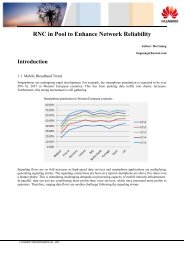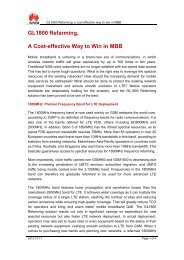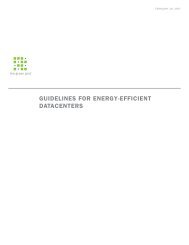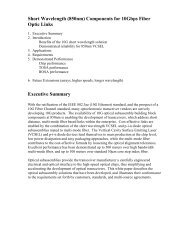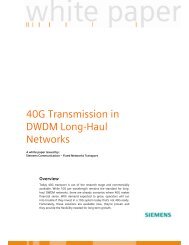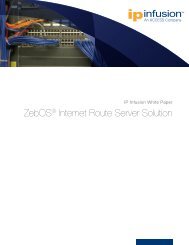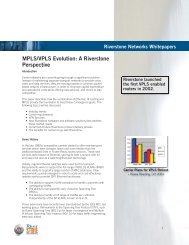Welcome to the Human Network - Light Reading
Welcome to the Human Network - Light Reading
Welcome to the Human Network - Light Reading
You also want an ePaper? Increase the reach of your titles
YUMPU automatically turns print PDFs into web optimized ePapers that Google loves.
With Flexible and Scalable Provisioning…<br />
The IP NGN Carrier E<strong>the</strong>rnet design provides a platform-independent architecture as well as a<br />
common command-line interface (CLI) and E<strong>the</strong>rnet-based services model across all Carrier<br />
E<strong>the</strong>rnet platforms. This allows for increased service flexibility and scalability across <strong>the</strong> network<br />
whereby multiple point-<strong>to</strong>-point and multipoint Layer 2-3 service types can be provisioned over<br />
<strong>the</strong> same physical port. Because VLANs have only port significance, scaling <strong>the</strong> number of service<br />
instances beyond <strong>the</strong> traditional 4000 limit on a device or network is no longer a problem. This new<br />
flexible provisioning also gives service providers a variety of VLAN translation mappings that help<br />
<strong>to</strong> uniquely track and scale services for <strong>the</strong>ir cus<strong>to</strong>mers. Scalability of <strong>the</strong> aggregation network is<br />
augmented by new 20 Gigabit line cards that support enhanced queuing, high availability, and<br />
Hierarchical Quality of Service (HQoS) functionality.<br />
… combined with Standards-Based OAM<br />
The IP NGN Carrier E<strong>the</strong>rnet design also achieves carrier-class resiliency and troubleshooting<br />
requirements. Standards-based OAM end-<strong>to</strong>-end across <strong>the</strong> access, aggregation, and<br />
distribution components allow service providers <strong>to</strong> manage E<strong>the</strong>rnet connectivity all <strong>the</strong> way<br />
<strong>to</strong> <strong>the</strong> cus<strong>to</strong>mer premises. This includes IEEE 802.1ag for service verification, IEEE 802.3ah for<br />
link-layer troubleshooting, and MEF E-LMI for service status and au<strong>to</strong> provisioning of cus<strong>to</strong>mer<br />
equipment. Cisco is unique in its ability <strong>to</strong> deliver E<strong>the</strong>rnet OAM all <strong>the</strong> way <strong>to</strong> <strong>the</strong> cus<strong>to</strong>mer<br />
premises and <strong>to</strong> link <strong>the</strong> access CPE <strong>to</strong> <strong>the</strong> intelligent Carrier E<strong>the</strong>rnet infrastructure.<br />
The IP NGN Carrier E<strong>the</strong>rnet Design is a highly available solution that supports sub-second<br />
multicast convergence and link res<strong>to</strong>ration across <strong>the</strong> end-<strong>to</strong>-end network. Using Fast Reroute<br />
(FRR) for <strong>the</strong> aggregation and distribution EoMPLS tunnels, 50 millisecond (ms) res<strong>to</strong>ration can<br />
be achieved for link res<strong>to</strong>ration. In <strong>the</strong> event of a node failure, recovery will also occur in less<br />
than one second. Overall, <strong>the</strong> Cisco IP NGN Carrier E<strong>the</strong>rnet design leads <strong>the</strong> industry in both<br />
scalability and resilience.<br />
Figure 3. Cisco IP NGN Carrier E<strong>the</strong>rnet Design







